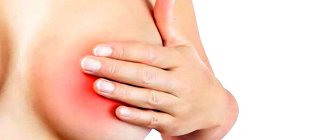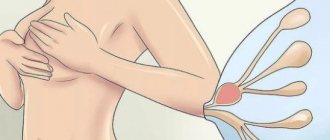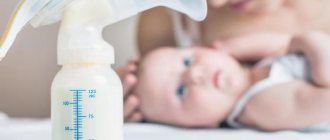Why express breast milk?
There can be many reasons for breast pumping:
- Congestion in the mammary gland, which can lead to mastitis. In this case, pumping is a necessary procedure.
- The baby weaned himself from the breast during the breastfeeding break and does not want to take the breast. Then the mother pumps and feeds the baby breast milk from a bottle.
- The breast is too full, the nipple is tense, the baby cannot latch on. Expressing a little breast milk will help ease the tension and your baby will feed on his own.
- Mom often has to leave for work or school. In this case, expressed milk will be an excellent alternative to adapted formulas.
- Taking medications by the mother leads to a forced break in breastfeeding, and pumping helps maintain lactation.
- Often you have to pump to increase insufficient lactation.
- If your breasts are too full and painful, and you cannot feed your baby, then pumping will help relieve the condition.
All these reasons are quite common, and the pumping procedure really makes life easier for a young mother. The main thing is to know how much and when to express breast milk so that the procedure brings relief and does not aggravate the situation.
Is pumping required after each feeding?
If there is a lack of breast milk, doctors advise expressing in the morning. Thus, it is not advisable to carry out the procedure after each feeding of the baby. In the evening, it is allowed to supplement the baby with natural milk formula, which has been pumped out with a sterile clean breast pump.
Experts note that holding the event once a day is safe. However, such measures are allowed only for a limited amount of time to normalize lactation. Otherwise, it is necessary to put the baby to the breast as often as possible. You need to understand that in the evening all women produce less nutrition for the baby than in the morning, but this process is natural and is explained by daily hormonal changes.
You can find out which breast pump is better to choose in our article. How to restore lactation after a break in feeding, read here.
Is it possible to give a massage to a nursing mother, read the link
Experts note that the lactation period largely depends on physical contact between a woman and her little child.
If the baby is fed on demand (at least 12 times a day), lactation will be stimulated. At the same time, the female body adapts to children's needs. If you regularly use a breast pump, incorrect information appears on a natural level, so serious failures begin to occur, and the woman faces numerous potential problems, including the development of inflammation.
When and how often should you pump?
The frequency of pumping procedures and the amount of milk received directly depends on the reason:
We recommend reading: Why does your chest hurt when breastfeeding?
- For congestion - once every 1-2 hours. You need to express the amount of milk that will be possible until the compaction decreases. The procedure should last at least half an hour, but no longer, since pumping for too long can injure the mammary gland.
- To increase lactation - after feeding and once or twice in between the child’s meals. The procedure lasts about 10 minutes after feeding and 15 minutes in between.
- To relieve breast fullness, it is enough to express only when discomfort is felt. In this case, you need to express very little milk only until you feel relief, since the more you express, the more milk will arrive next time. In this case, you need to express for no longer than 5 minutes.
- To maintain lactation during a break in breastfeeding, you need to express once every three hours, simulating the baby’s feeding schedule. The amount of expressed milk should be sufficient so that when breastfeeding resumes, the baby is full. The length of each procedure is from 20 to 30 minutes.
- In order to make reserves, it is enough to express several times a day in between the baby’s meals. The time and amount of expressed milk should be chosen so that by the next feeding the breasts have time to fill and the baby does not remain hungry. In this case, everything is individual and depends on the individual woman, the volume of her lactation and the rate of breast filling.
All about expressing milk: Q&A with a gynecologist
Breastfeeding is a unique process. We can talk endlessly about its advantages! But at the same time, this is a process that raises many questions for the new mother. What to do if your baby doesn't have enough milk? Do I need to express milk after feeding? How to maintain breastfeeding if a woman needs to go to work? All about expressing milk - in an interview with MAMA PRO expert, obstetrician-gynecologist Tatyana Pashuk.
Tatyana Pashuk Obstetrician-gynecologist, @doctor_tanusha_pashuk
In what cases does a mother need to express milk?
– It is necessary to express milk if:
- a woman has hypogalactia (when the level of milk production does not meet the needs of the child, i.e. the mother does not have enough milk);
- the baby is undergoing treatment (for example, in the intensive care unit, intensive care unit);
- Mom needs to go to work, study, or go somewhere for a long time;
- a woman will have to take medications that are prohibited while breastfeeding (for example, the mother has a cold and needs to take antibiotics);
- the mother has lactostasis (stagnation of milk in the breast), mastitis (inflammation of the mammary gland), hardened areas of the breast;
- the mother has a lactation crisis (a temporary decrease in the amount of milk), which sometimes happens during breastfeeding.
Is it necessary to express milk after each feeding?
If the mother does not plan to go anywhere, after feeding her breasts are soft, the baby has enough food - there is no need to express milk every day after each feeding. If you feed your baby as needed, there will always be enough milk. Why don't you need to pump after every feeding? When a mother expresses milk, the brain does not understand whether this is expressed milk or the milk eaten by the baby. At the next feeding, the mother receives more milk (how much the baby ate and how much the woman expressed). So, due to excess milk, a woman can develop lactostasis.
Why is pumping necessary at all?
In the first weeks of the baby’s life, until lactation is established, young mothers are sometimes recommended to express milk so that more milk comes in. But this opinion is not supported by all breastfeeding experts, because if the mother is healthy, then milk will come in sufficient quantities. Pumping can help in the following cases:
- if the mother has lactostasis, mastitis;
- if a woman has a lactation crisis. In this case, you can express in order to increase milk production;
- to create a breast milk bank
if the mother plans to lead an active lifestyle after childbirth (study, work, hobbies) and does not want to interrupt breastfeeding.
How can you express milk?
Expression can be done:
- manually;
- using a breast pump (manual or electric).
The choice of pumping method depends on how often the mother plans to pump. If a woman plans to go to work every day and create a breast milk bank, then it is better to choose a breast pump (preferably electric). This method is as convenient as possible for a woman and also saves time. If a mother periodically develops dense areas in the mammary gland, she can express by hand. If a mother expresses milk for the purpose of storing or creating a breast milk bank, it is recommended to use a breast pump. It will allow you to collect milk under sterile conditions. After all, it is impossible to treat your hands in such a way as to express milk as cleanly as possible and store it in the future.
How to express properly?
Basic rules before pumping:
- Wash your hands with soap.
- Additional washing of the mammary gland is not required - it is enough to perform normal hygiene procedures twice a day. But remember: if you regularly wash the mammary gland using various detergents, there is a risk of injury to the nipples (they will be dry and begin to crack).
- Be sure to wash and sterilize the container in which you will express. If a woman does not plan to give expressed milk to her baby (for example, she has problems with lactostasis), you can express it into a diaper or towel.
- There is no need
to massage the breast .
How to express milk by hand?
- With your thumb and index finger, grab the areola area (not just the nipple);
- Express the milk using suppressive movements. It is important not to massage or press hard on the mammary gland, avoiding injury.
You can make pumping easier by making forward movements with your fingers from the periphery to the nipple (radially). All milk ducts converge radially in the nipple area. This way you can “promote” the milk.
How long should I pump? How and where is the best way to do this?
You need to express for approximately 10-15 minutes until the mammary gland becomes empty. It is more convenient to do this while sitting. If a woman uses a manual breast pump or expresses with her hands, it is advisable for her body to be tilted forward. If a mother expresses using an electronic breast pump, then there are no requirements for body position.
What common mistakes do mothers make when pumping?
- incorrect hand expression mechanism. As a result - trauma to the nipples, bruises on the chest;
- failure to comply with hygiene rules. Mom must wash her hands before pumping, because bacteria can get into the milk. In this case, it will be stored less, and the baby will have a risk of developing gastrointestinal complications;
- storage errors. We will talk about proper milk storage below.
What problems can a mother face if she does not express milk?
If a woman has dense areas of her breasts after feeding, then she should definitely conduct a self-examination of the breast (the one she fed). If you do not pump, the milk will become clogged in the mammary ducts and lactostasis will form. In the future, this can lead to the development of mastitis - the woman’s temperature rises, the mammary gland becomes swollen, inflamed, painful, and redness of the skin in this area is observed. In the future, surgical assistance may be necessary.
How many times a day should you pump?
If a woman is pumping to create a breast milk bank, it is recommended to pump after each feeding, and sometimes between them. If a woman is faced with the problem of lack of milk, then after each feeding you can “pump” to stimulate milk production.
How to store expressed milk?
For hermetically sealed storage, there are special containers - cups or bags. They are made from special non-toxic and safe materials that do not impair the properties of breast milk. Milk can be stored:
- at room temperature – up to 4 hours;
- in the refrigerator - up to a day. If you store milk in the refrigerator, do not place it on the side shelf, but place the containers closer to the back wall of the refrigerator;
- in the freezer - up to 3 months.
If you plan to freeze milk, you should first put it in the refrigerator, and then, once cooled, put it in the freezer. Before defrosting, first place the milk in the refrigerator for 12 hours. The milk can then be warmed either at room temperature or using a water bath or special bottle warmers. Don't forget: you can't refreeze defrosted milk. Is it possible to express milk several times in one glass? Yes, if you express and store the milk in the refrigerator within 12 hours.
Advice from Mamapro.by: be sure to label the cups or bags of milk. It is important to do this so that the person who will feed the baby knows the expiration dates. The later the milk is expressed, the later it can be given.
What is the best way to feed your baby expressed milk?
Lactation consultants and World Health Organization specialists recommend supplementary feeding (expressed milk/formula) from a spoon
. This is necessary so that the baby does not forget how to perform sucking movements and does not refuse the breast in the future. This process is labor-intensive and long, but it is important so that breastfeeding is not disrupted. If you still do not have time to spoon feed and you are not afraid that this may have an adverse effect on breastfeeding, then try to choose a bottle with a nipple that closely follows the shape of the breast nipple. There are also special bottles that have a silicone spoon instead of a nipple - these are also well suited for feeding expressed milk.
Should a mother worry that her baby will refuse to breastfeed after a bottle?
If the baby is bottle-fed once or twice when the mother needs to go away, then there should be no problems. But if the baby is regularly bottle-fed, then in the future he will be lazy to take the breast. After all, most bottles are made in such a way that the baby does not need to make any effort to eat, the milk flows out on its own. The baby's sucking reflex begins to fade.
How much expressed milk should I give my baby?
Depending on the age norm, the amount of milk that is necessary to feed the baby is different, and its value will fluctuate throughout the day, because it depends on the daily biorhythms of the child. It is believed that on average per day a baby should eat a volume equal to ⅕ of the baby’s body weight. For example, a baby weighs 5 kg (5000 g), which means he needs 1000 ml of milk (formula). Divide this figure by the number of meals: if you feed your baby 10-12 times a day, then about 100 ml of milk is needed for each feeding.
0
Author of the publication
offline for 4 weeks
MamaPro.By
0
Publications: 395
How much milk can you express in one procedure?
It all depends on when mommy pumps. If immediately after feeding, you may not get a drop of valuable liquid. The exception is hyperlactation, when there is too much milk.
Immediately before feeding the baby, you can get 50-100 ml. This portion is enough to fully feed your baby with expressed breast milk. Sometimes even before feeding, mothers cannot strain anything - this indicates an incorrect technique.
Milk is expressed especially well at night, since it is at night that prolactin is produced and is responsible for milk production. Therefore, to replenish supplies, it is better to pump between 2 a.m. and 6 a.m.
The reasons for low pumping may be:
- The baby eats all the milk produced.
- Incorrect hand expression technique or poorly selected breast pump.
- Mom is too tense and can't relax.
- The woman neglects to prepare for pumping and does not wait for the tide.
Pros and cons of expressing milk
Regular pumping leads to numerous disputes. For this reason, it is necessary to understand what the pros and cons of the procedure exist.
Feeding according to the regimen involves the complete sucking of milk by the baby, as a result of which excess cannot remain. If you choose feeding at will, there is a risk that the baby will not suck out its nutrition completely, so excess will be recorded and it will affect the hormonal system, as a result of which lactation will proceed more slowly and less. To maintain breastfeeding, it is recommended to express more often so that there is still enough food for the baby. Based on this opinion, it is possible to understand why the procedure is still recommended by specialists.
Of course, there are arguments against it, so potential disadvantages are noted. If a baby is focused on personal needs, he will never require physical contact a precise number of times a day and after a certain time. It is important to understand that the baby may ask to be held by his mother, even if he does not feel hungry, but wants to calm down and eliminate the existing discomfort. The female body is not designed for stable lactation, so proper stimulation of the baby is required. There are virtually no risks to stopping breastfeeding completely, so you shouldn’t pump almost every time. Otherwise, the body will decide that the processes are not proceeding correctly and lactation may be disrupted.
Basic rules for expressing breast milk
If you follow these rules, pumping procedures will be completely safe and will only bring benefits:
- Pumping your breasts shouldn't hurt! If any painful sensations appear, this indicates an incorrect technique, and pumping must be stopped.
- Before the procedure, be sure to wash your hands with soap and prepare a clean, boiled container for the resulting dairy product.
- In order for pumping to go as quickly and painlessly as possible, you need to induce a flow of milk before it (wash your breasts with warm water, contact the baby, drink a warm drink, lightly massage the mammary glands, give one breast to the baby and express the other at the same time).
- After the milk has arrived, you need to express it by hand or use a special machine. When manually expressing, only the correct technique is important (you can learn more about how to express breast milk by hand in this article). When undergoing a hardware procedure, you should choose the right breast pump and accessories (read more about pumping here).
Massage the mammary glands carefully and gently, in a circular motion, without squeezing them.
Manual expression technique
It is necessary to alternately change the grip of the areola to horizontal and vertical. This type of pumping will be more effective.
The correct position of the fingers when grasping the nipple is indicated by green arrows. Red arrows indicate incorrect grip
Selecting a breast pump funnel according to nipple size
- The pumping process should not be too fast. Do not pull, press or tug on your chest too much. You need to work for 4-5 minutes with each mammary gland alternately.
- If you don’t manage to express the first time, then don’t despair. You need to try again, and soon everything will definitely work out. The main thing is not to be too zealous so as not to damage your breasts.
Features of artificial feeding
Artificial feeding of a child is based on feeding with milk formulas. If for some reason the newborn cannot receive breast milk, then he is transferred to formula. This is done after all possible measures to preserve HS have not helped.
Facts about bottle feeding:
- you need to choose only those formulas that are adapted to breast milk;
- not all mixtures are suitable for the baby;
- transferring to artificial nutrition is stressful for the child;
- formula milk is expensive.
How to pump your breasts for the first time
The first pumping will have to be done in the maternity hospital. Most likely, lactation will be abundant, and a newborn baby will not be able to eat so much milk. Pumping will help avoid congestion. Decantation is also necessary to relieve tension that prevents the baby from latching on to the nipple.
Basic principles:
- Don't panic or worry.
- Perform the very first procedure under the supervision of a nurse to ensure proper technique.
- Listen carefully to your feelings. There shouldn't be any pain.
- Express milk only until relief occurs, so as not to increase lactation even more.
Termination of lactation. Should you express milk when you stop breastfeeding?
When completing lactation, women also have something to worry about: it can be stressful for both mother and baby, but first of all it is a transition to a new stage of your interaction. Many related questions arise about how to properly end breastfeeding, avoid lactostasis and maintain the beauty of your breasts.
To understand whether you need to express your breasts when you stop breastfeeding, you need to remember again how the lactation process occurs. Milk in the breast is produced due to the continuous and coordinated work of hormones and your mammary glands. In simple terms, breast stimulation sends signals to your brain about your baby's increasing and decreasing needs. In accordance with them, there is a natural decrease or increase in the amount of milk.
This is what clogged milk lobules look like during lactostasis.
If you feel well, your breasts do not become hard, engorged or lumps form, there is no need to express milk! If you experience discomfort, your breasts are full and have become hard, in this case you can express milk until relief occurs, that is, a little. This way your body will understand that there is too much milk and will gradually reduce, and later stop, milk production.
How to express breasts during mastitis or congestion
Should I express my breasts during congestion and mastitis? Of course, pump! This is the main prevention and treatment of such conditions. Sometimes a mother can only get by with breastfeeding, but often even the child cannot resolve lactostasis. There are several features of the pumping procedure for mastitis and congestion:
- It is necessary to determine where exactly the seals have formed. This is usually felt immediately, but you can gently palpate the mammary glands to be sure.
- Before pumping, you need to lightly massage your breasts or take a warm shower. Water pressure and massage with light pats should be directed exactly where stagnation has occurred.
- Do not try to crush or knead the cones: this is extremely dangerous! Everything needs to be done as carefully as possible.
- If you have purulent mastitis, you should not heat your breasts!
- During the pumping process, direct your efforts to those lobes of the mammary glands where congestion has formed.
- Under no circumstances should you press on the place of stagnation!
If you follow these rules, pumping will be as painless as possible, and the unpleasant phenomenon of mastitis or congestion will gradually disappear.
Rules
To ensure that milk flows in sufficient quantities and the pumping process does not cause unpleasant associations, it is important to adhere to some rules:
- First you need to wash your breasts with soap;
- Prepare a sterile bottle;
- Movements should be smooth, avoid strong squeezing, do not rush;
- You can get milk from one breast first and then move on to the other;
- If the process of milk production is difficult, then you can perform a light massage;
- You should not express one breast for more than 5 minutes;
- It is not recommended to repeat the entire procedure more than 3-4 times a day, as this can lead to an excessive flow of milk.
What to do with the resulting milk? Many mothers are sincerely perplexed “where to put it”? Apparently, forgetting that this is the most valuable food for the baby! Therefore, our answer is, of course, to give it to the baby (if the mother did not take medications, alcohol, allergenic products, etc.)
Expressed milk can be given to the baby immediately, stored in the refrigerator until the next feeding and then heated or frozen.
Read further: what can a nursing mother eat in the first month. And also how long does it take for food to pass into breast milk?
How to do it for the first time
How many days does it take for milk to arrive? Usually the first flow of milk is observed on the third to fifth day after birth.
The speed of its appearance depends on how often the newborn is applied to an empty breast. In the first days, this must be done every 2 - 3 hours.
Such frequency will not only affect a faster flow of milk, but also the development of the nipple, which plays an important role in the process of feeding the baby.
It is the baby who prepares the necessary shape of the nipples for himself in the process of frequent attachment to the mother’s breast.
If the baby has just eaten the formula that is given out in the maternity hospital, it is not recommended to feed him for two hours. In this case, it is better to get rid of excess milk yourself.
To do this, you need to use gentle movements of your fingertips to carry out forward movements from the base of the chest to the alveoli. If there is a lot of milk, it will flow out on its own in a thin stream, which will alleviate the woman’s condition.
Often after giving birth, mothers sleep a lot, and therefore may not notice the first flow of milk. When you wake up, you may find hard breasts and disturbing pain. There is no need to panic as this is a natural process and can be dealt with in a few minutes.
The main thing is to calm down and gently knead the soft tissues with your hands. At first these actions will cause pain, but then it will pass.
Don't know how long to breastfeed your baby? Read the answer at the link.
Should I do this after every feeding?
Our grandmothers lived by the standards of the last century, in which pediatricians unanimously advocated ridding the breast of milk remaining after feeding.
It was believed that its remains in the ducts could lead to the proliferation of bacteria, which would harm the baby during the next feeding .
Therefore, leaving even an extra drop in the chest was considered almost a crime.
Feeding used to be carried out only according to a schedule developed by medical health organizations. The baby could only eat mother's milk every three hours. This regimen was mandatory in maternity hospitals, but even after discharge, most mothers strictly followed it.
A lot has changed today. Feeding on a schedule began to be carried out at the request of the mother herself. However, many women prefer to feed their babies on demand. This is correct, as it promotes full milk production and eliminates, in most cases, artificial stimulation of milk production.
And since the baby feeds based on his own desires, there is no need to get the last drops from the mother’s breast. Scientists have proven that the remainder of the dairy product in the ducts does not affect its quality in any way.
The only thing is that if the baby cannot suck out the entire volume in one go, then it is better to play it safe and drain the remaining milk, otherwise in the future the amount in the breast may decrease.
How to express during mastitis and congestion
If a woman discovers a lump in the breast, which is accompanied by pain or body temperature, it is necessary to consult a doctor as soon as possible.
Lactostasis is a stagnant phenomenon due to blockage of the milk ducts, it can be very dangerous .
In the first stages you may not even notice it. However, you cannot hesitate in such cases, since inaction can lead to the formation of a more serious disease such as mastitis.
As soon as the mother has felt the small ball inside the breast, it should be easily massaged with gentle movements of the fingertips. Under no circumstances should you press or put pressure on this place or try to split the lump . These unacceptable actions can lead to surgical intervention, and therefore you need to be extremely careful.
You should consult your gynecologist or call the breastfeeding hotline.
Typically, the recommendations of these specialists are as follows:
To make the process of softening the formed seal faster and less painful, you can take a warm shower. A light massage can be performed with directed jets of water. After water procedures, you need to continue softening the ball.
The best and most effective way to treat lactostasis is to put the baby to the breast. In this case, the baby’s lower lip should be directed towards the seal. This phenomenon can be eliminated within 24 hours. The maximum period of existence of lactostasis is three days.
If the blockage does not go away on the fourth day, be sure to consult a doctor.
Is it necessary to strain “stone” breasts?
When a mother leaves home for a long time, upon returning home she may find painfully hard breasts.
In this case, you can feed the baby. If this process is difficult for him, then it is necessary to resort to kneading the chest.
With light movements of your fingers, you need to ensure that the milk begins to appear drop by drop on its own . After the mother feels relief, she can put the baby to her breast. This situation should not be allowed to happen in the future.
This can lead to the formation of lactostasis and mastitis. As soon as the mother feels that the breasts are starting to harden, it is better not to delay releasing her from milk.
Is it necessary to express “stone” breasts?
Often in the first days after childbirth, you can observe the phenomenon of “stone” breasts. The mammary gland is hard and tense, there is swelling, the nipple is retracted or flat. Many experts believe that this is normal, the baby will suck at the breast, and the phenomenon will go away on its own. But in practice, a newborn cannot even latch onto the nipple to start eating. As a result, the baby is hungry, and the mother suffers from heaviness and discomfort.
Signs of a “stone” breast. She is shown on the right in the picture
Pumping will help you get rid of “stone” breasts. There are several rules:
- A breast pump will not help in this case. First you need to work on the nipple to give it the desired shape.
- Then you can start pumping. The milk will drip out in drops, this is a sign that the ducts have not yet developed.
- If you don't succeed right away, you need to try again. You can’t leave things halfway, as stagnation may form.
- You can try this method: grab the breast at the base with both hands and slightly pull forward towards the nipple. This will make milk flow easier.
- After expressing some milk, you can offer the breast to your baby. If the nipple is formed and the main tension is gone, then the baby will cope on its own.
Nipple shaping
When to pump
Needless to say, not everything is so good and rosy in everyday life. Lactation is one of those important moments when there is a need to endure inconvenience for the sake of the child. Therefore, expressing milk after feeding on demand may be due to the following reasons:
- forced separation from the child, when a woman wants to maintain lactation and does not plan to transfer the baby to artificial feeding;
- at the birth of a premature, low-weight baby, who, more than other children, needs additional feeding and additional nutrients;
- if the baby for some reason cannot breastfeed (for example, a herpetic infection on the oral mucosa);
- if the mother needs to take medications that are not compatible with lactation, in this case you can express a certain amount of milk, freeze it and begin drug treatment;
- with a temporarily forced break, but a desire to continue lactation in the future (for example, due to illness);
- when cracks occur in the nipples, anatomically flat or inverted nipples;
- if the child's sucking reflex is impaired.
The main purpose of pumping in such cases is to maintain lactation in the future. After all, mother's milk is the best nutrition for a child and no other product or mixture can replace the invaluable composition that the baby receives from the mother. In this case, pumping allows you to provide the baby with nutrition, and protect the mother from possible complications - mastitis, lactostasis and abscess.
You need to understand that such circumstances are rather exceptions to the rules, force majeure, which do not happen to every woman, but require the right approach to the situation.
Video about the need to pump after feeding your baby
How to feed your baby expressed milk
In order to feed your baby expressed breast milk, it must be heated to a temperature of 36 degrees. If the milk has been in the refrigerator, then it is heated in hot water, in a water bath or in special electric heaters.
Frozen milk must be taken out and placed in the refrigerator so that it takes on a liquid form. After this, it is heated as described above.
Experts do not recommend using microwave ovens to heat milk, as microwaves destroy its structure and destroy many beneficial substances.
During storage, milk may separate into fractions, then before drinking you need to shake the bottle several times, and it will return to its original form.
When milk is taken out of the freezer or refrigerator, it must be used all at once. Remains must be thrown away
When you can't do without pumping
If a baby is born premature, to maintain his vital functions he has to be fed through a tube; he will not be able to suck on his mother’s breast on his own, he will still be too weak. In this case, the mother must pump in order to at least supplement the newborn’s feeding: first with colostrum, and then, when the milk begins to flow, with breast milk.
In the first days, this is of great importance, since in the case of premature babies, maternal colostrum has a specific composition, almost unique in nature in its medicinal properties. Every drop will count.
To maintain lactation at the required level, you need to express both breasts. This will continue until the baby recovers and is given to you - then he will be able to feed on mother’s milk on his own.
Is it possible to mix milk expressed at different times?
The ideal option is to express each time into a separate container, but if this is not possible, then you can mix the expressed milk, following a few rules:
- Collect and mix expressed milk for one day only.
- Each portion should be expressed into a separate container and then cooled in the refrigerator to the same temperature.
- Do not mix breast milk of different temperatures!
Many experts generally do not advise mixing milk expressed at different times, since the composition and taste of the liquid is different each time. When mixed, the taste may change unpredictably, the child will simply refuse to drink it, and all the work will be lost. Therefore, mixing is a necessary measure that should be avoided if possible.
Pumping is not difficult at all. If you follow simple rules, this procedure will be an excellent assistant during breastfeeding.
When you can do without pumping
The most natural situation is as follows:
- the birth was successful and the baby was put to the breast almost immediately;
- the baby quickly and actively began to suck on his mother’s breast from the very first days;
- already on the third day the mother has enough milk and feels good;
- The baby eats whenever he wants, but between feedings an average of two hours passes during the day, and about three to four hours at night. But it is on average that the intervals may differ in different periods;
- the same situation continues after the mother and baby are discharged from the maternity hospital.
In other words, if the mother’s breasts are replenished with milk, and this volume is enough for the baby to feed throughout the day, then there is no need for pumping - the baby himself will be able to regulate the lactation process, simply sucking as much as he needs. Over time, when the baby grows a little, he will need more milk. In this case, he will begin to suck the breast more actively, as a result of which milk production will increase in a completely natural way.
The process of expressing milk from two breasts using a breast pump










